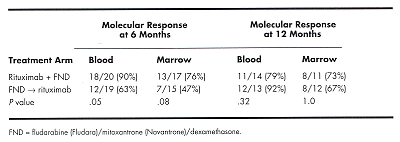Molecular Responses With Fludarabine, Mitoxantrone, and Dexamethasone Plus Rituximab Chemoimmunotherapy for Stage IV Indolent Follicular Non-Hodgkin’s Lymphoma
Stage IV indolent lymphomas are currently considered incurable disorders. However, the achievement of an early molecular remission, as determined by the bcl-2 polymerase chain reaction (PCR) assay, is associated with a better outcome. In view
Stage IV indolent lymphomas are currently considered incurabledisorders. However, the achievement of an early molecular remission, asdetermined by the bcl-2 polymerase chain reaction (PCR) assay, is associatedwith a better outcome. In view of its excellent correlation with failure-freesurvival, the PCR technique has the potential of providing a tumor marker thatcan be used as an early surrogate end point.
In the search for a treatment that could result in a highermolecular response rate, we designed a study that combines eight courses of FND(fludarabine [Fludara], mitoxantrone [Novantrone], dexamethasone [J Clin Oncol14:1262, 1996]) plus the monoclonal antibody rituximab (Rituxan). One of theaims was to determine which schedule of rituximab/chemotherapy is superior. Werandomized between the potentially synergistic concurrent antibody/chemotherapycombination vs delayed administration of antibody (which takes advantage of therecovery of immune function at the time of rituximab administration).
We have entered 134 previously untreated patients with stage IVindolent non-Hodgkin’s lymphoma (NHL) to either concurrent rituximab + FND(rituximab given on day 1 of the first six FND courses) or to delayed FND ®rituximab (FND first, followed by rituximab ´ 6starting 12 months later). All patients received interferon ´1 year. After eight courses of FND we have baseline PCR data on 95 follicularNHL patients, 70 of which (74%) had bcl-2 rearrangement in peripheral blood (PB)and bone marrow (BM). Median follow-up is 12 months. Of the 70 patients atbaseline, PCR data are currently available after 6 months of treatment in 39 PBand 32 BM, and at 12 months in 27 and 23, respectively. The data are shown inthe table below (6- and 12-month data in the delayed arm are before rituximabadministration):

CONCLUSION: At 6 months a higher molecular response in PB wasseen in the concurrent rituximab + FND arm; the same trend was seen in BM, butat 12 and 18 months the molecular response rate was equivalent for both arms.The projected failure-free survival (FFS) rate at 24 months is 88% for PBmolecular responders at 6 months vs 34% for nonresponders (P = .05). Atthis point there is no significant difference in FFS between the two arms of thestudy, although the trend favors the concurrent arm.
Click here to read Dr. Bruce Cheson's commentary on this abstract.
Targeted Therapy First Strategy Reduces Need for Chemotherapy in Newly Diagnosed LBCL
December 7th 2025Lenalidomide, tafasitamab, rituximab, and acalabrutinib alone may allow 57% of patients with newly diagnosed LBCL to receive less than the standard number of chemotherapy cycles without compromising curative potential.
Highlighting Insights From the Marginal Zone Lymphoma Workshop
Clinicians outline the significance of the MZL Workshop, where a gathering of international experts in the field discussed updates in the disease state.